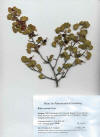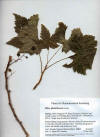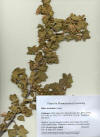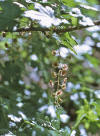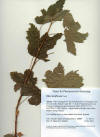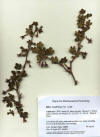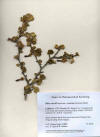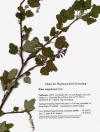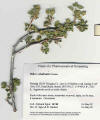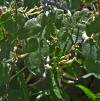|
Ribes amarum |
Ribes cereum
|
|
|
Ribes californicum Kern County,
|
Ribes cereum
Oregon, Cascade Ranges, Deschutes Natl. Forest, |
|
|
Ribes cereum |
Ribes cereum |
Ribes cereum Rocky Mts.—Colorado. Larimer Co.: Roosevelt Natl. Forest, Hwy 14, ~30 mi west of Fort Collins along the Cache La Poudre River; 40º41'53.5", 105º26’30.2”, 1982 m. Pine forest-desert transition. SPJ-16409, 3 Aug 2008
|
|
Ribes glandulosum
|
Ribes indecorum
|
Ribes inebrians |
Ribes
cf. inerme
|
Ribes lacustre
|
Ribes laxiflorum
|
|
Ribes
montigenum
|
Ribes nevadense
|
Ribes nevadense S Sierra Nevada, Greenhorn
Mts.
|
|
Ribes
quercetorum
|
Ribes
quercetorum
|
Ribes roezlii var.
cruentum |
|
Ribes cf. roezlii |
Ribes roezlii var.
cruentum
|
Ribes roezlii var. roezlii Kern County,
|
|
Ribes roezlii var.
roezlii
|
Ribes roezlii var.
cruentum
|
Ribes sanguineum
|
|
Ribes sanguineum |
Ribes velutinum
|
|
Ribes viburnifolium |
Ribes viscosissimum |
Ribes viscosissimum |
|
Trees and Shrubs of Kern County (Jan 2013, May 2015) Grossulariaceae (Gooseberry family) Ribes. Mostly deciduous shrubs, with spines, bristles or glandular hairs; leaves alternate, heart-shaped, digitately lobed with toothed margins, often clustered on short spur shoots; flowers usually pedicelled on simple scapes that are axillary to leaves or terminal on spur shoots, few to numerous, rarely solitary; pedicels with bracts at base; sepals and petals 5, rarely 4, the sepals usually more conspicuous, white, red, purple, yellow or green, petals often different in color, alternating with the sepals; gynoecium of two united carpels including the styles, with parietal placentation; ovary 1-celled, surrounded by the lower portion of the sepals united to form a hypanthium that sometimes extends above the ovary as a tube from which the sepal lobes are reflexed, spreading or erect; stamens as many as the petals, alternating with them, red, purple, black or green, spiny or sticky. ~120 spp., temperate Eurasia, Andes, 31 in California, 12 in Kern County. Commonly known as goose berries and currants, the former generally erect and spiny without jointed pedicels (previously Grossularia), the latter sprawling, without spines and with jointed pedicels (Ribes). Berries of indigenous species mostly used in Europe in pies, jam, soft drinks, also ornamentals; American Indians used berries (R. cereum) for preparing buffalo “pemmican“(dried meat paste, like jerky), or ingested directly as food (R. aureum, R. montigenum) but cautiously to avoid eating too many not to become sick (Ebeling 1986). 20 species reported as remedies for a variety of ailments; root from 12 species used to treat diarrhea, as a febrifuge, “inward troubles (root bark), boils, for” kidney troubles,” “uterine troubles”, to expel worms (root bark), for sore eyes, as a daily eyewash, sore throat, constipation, charley horse, toothache, tuberculosis (with bark of R. laxiflorum), or generally as a panacea (R. hudsonianum); bark, particularly “inner bark” from 4 species for pile remedy, hemorrhoids, poultice for swellings, eye wash, colds; sores; stem with or without bark for poisoning, colds, diarrhea, sore eyes, to prevent blood clotting; twigs of one species for body aches; berries for gonorrhea, laxative, back pain, emetic (R. pinetorum), nerves (Moerman). 91 extracts screened by the NCI prior to 1980; three active, R. bogotanum twig from Colombia (P-388 Leukemia), R. bracteosum stem from Washington (Lewis Lung), and R. ereythrocarpus whole plant from Oregon (Sarcoma). Key to Ribes 1. Stems with spines; plants usually not fragrant....................................................... 2 1. Stems without spines; plants often fragrant. ......................................................... 9
2. Ovary with spines; flowers red and white or purplish, fruit red.............................. 3
2. Ovary without
spines but with long glandular hairs in one species;
3. Twigs bristly,
leaves on upper surface ruffled between veins, often shiny,
3. Twigs not bristly;
leaves on upper surface flat, often dull, not
4. Flowers/fruits on
dangling pedicels;
sepals reflexed to tip of ovary;
4. Flowers/fruits on
spreading recurved pedicels; sepals reflexed to base
5. Floral tube and sepals maroon…………………………………....Ribes amarum 5. Floral tube yellow or partly yellow, not maroon…………………...……………...6
6. Plants low
spreading to 1 m; fruit red; leaves short glandular
6. Plants up to 2 m
with long arching branches; fruit purple to black;
7. Twigs not bristly;
sepal recurved, ribbon-like; petals similar in color to
7. Twigs
bristly; sepals spreading but not reflexed, star-shaped (rotate);
8. Branches long
recurved with successive internodes
± in
8. Branches mostly
erect, younger branches sometimes abruptly
9. Flowers long
tubular with short reflexed lobes; fruits red;
9. Flowers bell-shaped
to urn-shaped, lobes ~long as tube, spreading to
10. Flowers externally
greenish or greenish white with pink tinge, 4–15 in
10.
Flowers externally
rose to red, 8–25; petioles glandular or not; fruit
11. Flowers 10–25 in
loose subcylindrical clusters; floral tube
11.
Flowers
8–12 in tight conical clusters; floral tube bowl-shaped,
Ribes amarum McClatchie 1894. Bitter gooseberry. Spiny-stemmed shrub, stems low spreading to erect with long horizontal slightly zigzag branches, to 2 m; spines 3, bristles none; twigs gray to brownish or pale orange, minutely hairy; leaves on short spurs, the blades on erect petioles, pale green, round in outline, 2–4 cm, divided one third to two-thirds way into 3 wedge-shaped lobes, the lobes irregularly divided into triangular teeth or lobes. Flowering Feb–Apr (-Jun); flowers 1 or 2 together, spreading recurved on short scape-like stems (peduncles), subtended by small concave bracts; floral tube cylindrical, 6–7 mm, purplish red or maroon, sepals purplish red, reflexed, petals white, erect 2 mm. Fruit: berry red or purplish, densely covered glandular hairs. Chaparral and montane forests below 6,000 ft, Monterrey, Tehama and Eldorado cos. south to San Diego Co., California. Type from San Gabriel Mts., CA. Kern Co.: Rare, Caliente Canyon ,701 m (Twisselmann 26 May 1964, CCH), and Greenhorn Pass ( photo, Spjut, Jun 2010), 701–1,600 m. Ribes californicum Hooker & Arnott 1838 var. californicum. Hillside gooseberry. Intricately branched spiny shrubs to 1.5 m; stems with 3 stout straight to curved spines per node, not bristly; leaves thick, round in outline, 3–5 lobed, 1–3 cm, margins with shallow rounded incisions; glossy above, mostly hairless or with occasional glandular hairs on petioles. Flowering Feb–Mar; flowers often 1, to as many as 3, pendulous, sepals greenish to dull white or with some purple, reflexed, ovary densely bristly, with glands at the tips of shorter bristles; fruit: berry ruby red with porcupine-like bristles, longer than diam. of fruit. Chaparral, foothill woodland and mixed evergreen forest, 45–1,400 m; Coast Ranges from Mendocino to Los Angeles Cos. Type from California without specific locality. Kern Co.: Joe Messa Spring near summit of Messa Canyon, Temblor Range (Twisselmann); also reported from Bodfish (CCH: R. Hoffmann, 28 Apr 1940). Var. hesperium (Ribes hesperium McClatchie 1894) Jepson 1925, distinguished by hairy leaves (bald in the typical variety) and shorter stamens, is reported in CCH specimens from the Mt. Pinos region in Ventura Co., and on a checklist of plants for the Tejon Ranch. Ribes cereum Douglas 1830 var. cereum. Wax currant. Shrubs densely branched with stiff but flexible stems, to 1 m high and 2 m broad, without spines or bristles; leaves rounded to kidney shape in outline, slightly wider than long, notched at base, 1–4 cm wide, 3–5 lobed, glandular except on upper surface, shallowly and bluntly toothed along margins. Flowering Jun–July; flowers cylindrical tubes that are white to lavender tinged, generally 3–7 in tight clusters on short flower stems with leaf-like spreading toothed bracts that are 4–7 mm. Fruit: berry glossy red, mostly smooth except for minute scattered glandular specs. Open brushy slopes or forest understory, usually rocky places, (3,000-) 5,000–12,600 ft; Montana to British Columbia, south into montane forest regions of California to Santa Rosa Mts., east to northwestern Arizona and southern Utah. Type collected on decayed granitic or schist along the Columbia River from the Great Falls (The Dalles) to its source. Kern Co.: Common around exposed summits and ridges in understory of pine forest (Twisselmann); southern Sierra Nevada and Transverse Ranges, 1,768–3,049 m (CCH). Ribes lasianthum Greene 1896. Woolly-flowered gooseberry. Shrubs <1m, stems gray, with 1–3 yellowish spines per node; twigs thick, short hairy; leaves round, deeply 5–7 lobed, and with additional shallower lobes, 1–2 cm, with scattered glandular hairs on the blades, more densely glandular on petioles. Flowers Jun–Jul, yellow, 2–4 on short scapes, with short cylindrical tubes 5–6 mm, sepals curled back or later uncurled. Fruit: berry, red and smooth. Primarily rocky places, 7,000–10,000 ft; Sierra Nevada with scattered occurrences in San Gabriel and Gavilan Mts., to Nevada, Oregon. Type from above Donner Lake, toward Castle Peak. Kern Co.: Kern Plateau; Owen's Peak Wilderness; ridge along the Sierra crest less than 1 mile north of Owen's Peak at 2,439 m; Scodie Mts., Kiavah Wilderness, along the Pacific Crest Trail, E face of Skinner Peak, 2,073 m (CCH). Ribes malvaceum Smith 1815. Chaparral currant. Shrubs with one to many erect stems from base, 1–2 m; twigs reddish brown, hairy and glandular; leaves erect, thick, round in outline, 2–6 cm, 3–5 lobed often like a maple leaf, gray to white glandular hairy beneath with thick raised veins, upper surface ruffled (rugose) between lateral impressed veins, with glandular hairs; margins with triangular teeth, shallow and broadly notched at base (blade); flowers Oct–Mar, 10–25 clustered on scape-like stems that exceed the leaves, vase-like, the tube cylindrical, pink to rose outside, pale pink to white inside, 5–8 mm, glandular hairy, sepals hood-like (cucculate), widest above mid region, broadly rounded to apex, 3–4 mm, erect at first, then spreading (rotate); petals shorter, < half the width and length of sepals, erect. Fruit: berry purplish black, hairy and glandular. Mostly below 4,000 ft in foothill woodland and chaparral bordering Inner Coast Ranges to Transverse Ranges. Kern Co.: Rare, Douglas oak woodland, east slope, Blue Mt, Greenhorn Range (Twisselmann); 1 mile northeast of Castaic Lake, 1,066 m (CCH: E. R. Blakeley, 3 Mar 1958). Ribes menziesii Pursh 1814 var. ixoderme Quick 1938. Canyon gooseberry. Branching spiny shrubs to 2 m; stems densely bristly and with 3 spines per node; leaves aromatic, round in outline, 1–4.0 cm, 3–5 lobed, with smaller shallower lobes, notably glandular hairy below; ruffled and bubbly above. Flowering Apr; flowers purplish, floral tube 2–3 mm, sepals reflexed, petals white. Fruit: berry red, densely bristly. A relatively rare variety in the southwestern Sierra Nevada and Tehachapi Mts.; chaparral, montane woodland; 900–1,100 m Fresno and Kern Cos. Kern Co.: Douglas oak woodland, east slope of Blue Mt, Greenhorn Range, and Caliente Canyon, 2,300 ft (Twisselmann); Linns Valley west of Glennville and three scattered locations from 4.1 to 5.5 km west of Pastoria Creek in the Tehachapi Mts., 940–1,110 m (CCH). Ribes montigenum McClatchie 1897 Mountain gooseberry. Low shrub, generally with straggling branches, not more than 60 cm high; stems bristly and prickly with 3–5 nodal spines; twigs glandular hairy; leaves 0.5–2.5 cm wide, deeply cleft and with incised lobes; glandular hairy on both surfaces; petioles glandular hairy; flowers few in clusters, the tube straw-colored; petals red, crescent shaped; berry red, sparsely glandular hairy, the hairs appearing rather stiff. Dry montane forests, Rocky Mts. and west to California, and British Columbia, generally above 7,000 ft in the Sierra Nevada where known as far south as Tulare County; may be expected in Kern County. Ribes nevadense Kellogg 1855. Sierra currant. Shrub openly branched with slender stems without spines and bristles, 1–2 m; twigs minutely hairy; leaves horizontal on erect petioles, thin, round in outline, 3–7 cm, 3–5 lobed, ruffled above between the impressed veins, with surface transparent glands, otherwise mostly hairless, lower surface minutely hairy, margins with broad triangular teeth. Flowering May–Jul; flowers rose to red, floral tube ~5 mm; sepals erect, pink to red. Fruit: berry, blue to black with scattered tack-shaped glands. Stream banks in montane forests, 3,000–10,000 ft, southern Oregon to San Diego Co., to western Nevada. Type thought to be from Placerville, CA. Kern Co.: Common in the pine forest, occasional in chaparral and red fir forest, 1,220–2,378 m (Twisselmann, CCH). Fruits used for making jelly (Twisselmann). Ribes quercetorum Greene 1885. Oak woodland gooseberry, chaparral gooseberry. Large spiny-stemmed shrub, generally wider than tall, with many long arcuate branches, to 2 m high and 5 m broad, the internodes not in a zigzag direction; spines usually 1, bristles none; twigs gray, minutely hairy, with black lenticels; leaves on short spurs, pale green, round in outline, 1–2 cm, divided about half-way into 3–5 wedge-shaped lobes, the lobes in turn shallowly divided into 3 triangular lobes. Flowers Jan–Apr; flowers pendulous on short simple to branched flower stems, subtended by bracts shallowly toothed along apical margin; floral tube cylindrical, 6–7 mm, pale yellow’ petals white ~ 1 mm. Fruit: berry black. Foothill woodland below 6,500 ft bordering southern half of Great Valley to Sierra San Borja, Baja California. Type from Paso Robles, CA. Provisional oak gooseberry thickets recognized in MCV2. Kern Co.: “A common and characteristic shrub of the Douglas oak woodland, often forming large dense colonies” (Twisselmann), also California juniper and grey pine woodlands, and montane chaparral, Walker Pass, trail along Bartolas Creek in Domeland Wilderness, Greenhorn Range near Glennville, Tehachapi Mts., Cuddy Valley, and San Emigdio Range, 450–1,900 m, (CCH). Ribes roezlii Regel 1879 var. roezlii. Sierran gooseberry. Spiny-stemmed shrub, stems erect with wide spreading slightly zigzag branches, to 1.5 m high and broad; spines 1–3, bristles none; twigs reddish, minutely hairy; leaves on short spurs, pale green, round in outline, 1–2.5 cm, divided about half-way into 3–5 wedge-shaped lobes, the lobes irregularly divided into triangular teeth or lobes. Flowers Apr–Jun, 1 or 2 together, pendulous on short scape-like stems (peduncles), subtended by small concave bracts; floral tube cylindrical, 6–7 mm, purplish red, sepals purplish red, reflexed, petals white, erect 3–5 mm. Fruit: berry purplish, densely covered with stiff spines. Montane forests below 8,500 ft, Oregon to San Diego Co., California, mostly in the Sierra Nevada, Transverse and Peninsular ranges. Kern Co.: Common on north slopes in the yellow pine forest, occasional in the Douglas oak woodland and desert-facing canyons of the pinyon woodland; in the Tehachapi Mts., east of Keene dense covers of an acre or more on north slopes at the upper limits of the Douglas oak woodland such as at the heads of Tollgate and Stevenson canyons (Twisselmann, var. cruentum not distinguished), 761–2,439 m (CCH). Ribes roezlii Regel var. cruentum (Ribes cruentum Greene 1899) Rehder 1916. Distinguished by the absence of hairs on the undersurface of leaves. A North Coast Range variety with scattered occurrences in the Sierra Nevada. Kern Co. Head of Indian Wells Canyon, 6,200 ft and Ft. Tejon; 1006–1,889 m (CCH). Also along the Mill Creek Trail near creek under Canyon live oak just below sagebrush scrub zone, probably around 3,600 ft (Spjut & Golden obs., photo). Ribes velutinum Greene 1885 [Includes R. glanduliferum A. Heller 1905] Velvet gooseberry. Kern Co.: Large spiny-stemmed shrub, stems many from the base, thick, rigid, erect, zigzag, occasionally with spreading to short recurved branches, to 2 m high and broad; spines 1–3 (with shorter lateral spines); bristles none; twigs whitish gray, minutely hairy, the bark becoming reddish orange on older stems; leaves on conspicuous spurs, pale green, round or kidney-shaped in outline, 0.5–2 cm, divided about one-third into 3–5 partly wedge-shaped lobes—in the lower two-thirds, the upper third usually tapered, the lobes shallowly divided into 3 broad triangular lobes. Flowers May–Jun, 1–3 (-5) in clusters oriented in various directions along various points of the main stems, yellowish to pale white or pinkish, on short pedicels (< 4mm) arising from spur shoots among the leaves, subtended by shallowly toothed bracts along apical margin; floral tube bowl-shaped to cylindrical, 3 mm, pale yellow’ petals 2 mm. Fruit: berry reddish purple, short velvety hairy. Sagebrush scrub to pinyon-juniper or mahogany woodland to ponderosa pine forest below 8,500 ft, Blue Mts. Washington and Oregon, Klamath Region in Oregon and California, California Cascade Region, Sierra Nevada south to Transverse Ranges, desert mountains to Utah and northern Arizona. Type from northern CA. Kern Co.: Occasional, Jeffrey pine forest, limber pine forest, Joshua tree woodland; Mt. Pinos, Tehachapi Mts., Piute Mts., scarce in Douglas oak woodland (Twisselmann); 731–2,500 m (CCH). Ribes viscosissimum Pursh 1814. Sticky gooseberry. Aromatic shrubs with erect and spreading stems, to 2 m high and 2 m broad, without spines or bristles; twigs sticky, pinkish turning gray with age; leaves rounded to maple-like in outline, the blades on erect petioles to 5+ cm, slightly wider than long, notched at base, 2.6–10 cm wide, 3–5 lobed, sparsely to densely glandular on both surfaces, shallowly and bluntly toothed along margins. Flowering May–Aug; flowers generally 4–15 on short scape-like stems at ends of peduncles, tubular to bell-shaped, greenish white to yellow, or tinged pink, with leaf-like spreading toothed bracts 6–8.5 mm. Fruit: berry bluish black, not notably fleshy, glandular hairy. Open brushy slopes or forest understory, usually rocky places, 5,000–9,500 ft; Colorado, Utah and Montana to British Columbia, south into montane forest regions of California to Kern Co., east to northern Arizona, and with an isolated occurrence in southeastern Arizona. Type from northern CA. Kern Co.: Small colony under chinquapin, north slope of Sunday Peak (Twisselmann), also Greenhorn Summit on Rancheria Rd near Hwy 155 (C. Golden comm.), and Breckenridge Mt (Golden & Spjut obs., photo).
References on medicinal uses Takata R., T. Yanai, R. Yamamoto and T. Konno. 2007. Improvement of the antitumor activity of black currant polysaccharide by an enzymatic treatment. Biosci. Biotechnol. Biochem. 71(5): 1342–1344. “A polysaccharide-rich substance isolated from black currant, named cassis polysaccharide (CAPS), was partially digested with beta-galactosidase from Aspergillus oryzae and its immunostimulatory activity was investigated. The in vitro cytokine-inducing effect of CAPS on RAW264 cells was gradually decreased along with lowering of the average MW of CAPS. In vivo, partially digested CAPS with a mean MW of approximately 20,000 showed the most potent antitumor activity against Ehrlich carcinoma in mice.”
|
||





